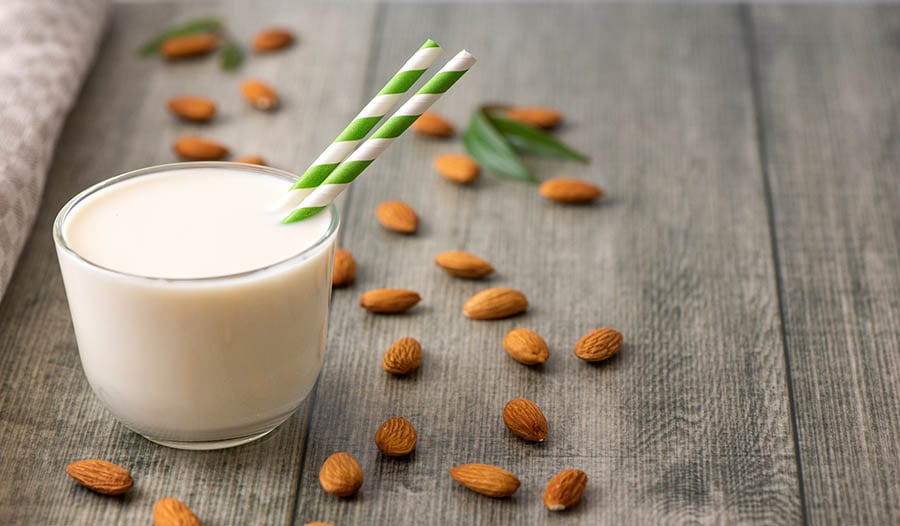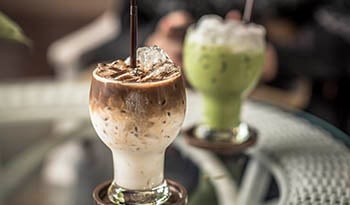3 Easy Dairy-Free Substitutes
DISCLAIMER:This blog does not intend to provide diagnosis...
- In this article:
- Reasons to Go Dairy-Free
- What to Look for in a Dairy-Free Substitute
- Almond Milk Recipe for Milk Substitution
- Chia Pudding for Yogurt Substitute
- Nutritional Yeast for Omelet and Cheese Substitute

There are plenty of reasons to go dairy-free, yet it is very difficult when most modern recipes include at least one product that contains milk. Fortunately, there are a few easy substitutes that make it easy to cook without dairy.
The modern diet contains dairy in almost every dish, but more and more are realizing that eating dairy is not always the best option. People do not have to give up on tasty foods just because they have a dairy allergy or want to follow a vegan diet. There are common cooking staples that can easily be substituted for dairy in almost any recipe.
Reasons to Go Dairy-Free
Dairy is one of the most common allergies with which people around the globe are afflicted, so there are thousands of individuals who cannot eat this food at all. There are also many common diets that do not allow people to consume dairy. Those who follow a paleo diet should not have dairy because humanity's hunter-gatherer ancestors did not milk cows. Another common regimen that does not allow dairy is the vegan diet that tries to avoid all animal products entirely.
Countless individuals find that they do not have a specific dairy allergy, yet they feel better when they eliminate milk products from their diet. Earlier humans were only able to process lactose as infants and grew out of it as they aged. Roughly 70 percent of people globally have at least some trouble digesting lactose, so avoiding dairy can improve digestion or bowel issues. Avoiding dairy has also been linked to reduced inflammation, which may help prevent a wide variety of health problems ranging from acne to chronic illness.
What to Look for in a Dairy-Free Substitute
To get into all the details of dairy substitutes, it is necessary to look at what dairy provides in most recipes. The main thing that dairy products like cheese, cream, or butter add to a recipe is a creamy taste and feel. This is due to the high-fat content in dairy. Fat helps heighten flavors and provides a softer, moisture texture. Therefore, the simplest dairy-free substitute is just using olive, canola, avocado, or another type of oil in meals.
Dairy substitutes can get a little more challenging when it comes to replacing butter for baking. As a saturated fat, butter is solid at room temperature, resulting in some interesting structural properties. If the plan is to use a butter substitute for baking or other complicated recipes, consider a substitute like coconut oil, which is also firm at room temperature.
Certain types of dairy add pronounced flavors as well. Yogurt has a subtle tang that works well in both sweet and savory dishes. Cheese is an even more complex dairy product that can make things taste salty, yeasty, and sharp. To replace these types of dairy, it is necessary to get substitutes that both replace fat and flavor. Depending on what recipe a person is following, dairy's final role is to provide substance. A substitute may need to replace a set amount of liquid or solid mass in a recipe to get the right results.
Almond Milk Recipe for Milk Substitution
Almond milk is one of the ideal substitutes for any recipe that calls for milk. It has a slightly more neutral taste than soy milk or other milk substitutes, yet it is still rich and creamy. When a person is substituting almond milk for milk in a recipe, they can do a simple 1-to-1 substitution. For example, if someone needs a cup of milk for a béchamel sauce, they just need to sub in a cup of almond milk.
For best results, it is usually a good idea to use homemade almond milk instead of store bought. Store-bought almond milk can be a little too sweet from all the added sugars. Homemade almond milk also has an extra note of creaminess and flavor that cannot be reproduced in store-bought milk. A nice bonus is that people can personalize their almond milk to reach their desired level of sweetness and thickness. Here's a great recipe for making almond milk at home.
Ingredients:
- 1 cup raw, organic almonds
- Enough water to cover the almonds
- 2 cups water
- 1 Tbs. honey, agave nectar, or another sweetener (optional)
Instructions:
- Put the almonds in a container and add enough water to fill up the container at least 1 inch above the almonds.
- Leave the almonds at room temperature and allow them to soak at least eight hours. They can be left soaking for up to 24 hours if desired, but a little extra water may need to be added for longer soaks.
- Drain the water and rinse the almonds carefully under water. Do not use the soaking water further because it can have a slightly bitter flavor.
- Put the almonds and 2 cups of fresh water in a food processor or blender.
- Pulse the mixer until the almonds are ground down into tiny pieces and scrape down the sides. Then, run the mixer on its highest speed nonstop for two minutes.
- Line a colander with cheesecloth and pour the mixture through it to strain the almond milk. Once the liquid runs through, carefully gather up the cheesecloth around the remaining mixture, twist it closed, and squeeze out all remaining milk.
- Stir in the sweetener if desired.
- Store in the refrigerator and enjoy over the next two days.
Chia Pudding for Yogurt Substitute
Yogurt is one of the more challenging dairy substitutes because it is often eaten on its own or used as both a thickener and an acidic ingredient in recipes. Depending upon which recipe the yogurt is being used, a person may need a fairly sour substitute to get the right flavor. Vegan yogurt meant to be eaten on its own has to be particularly tasty since there aren’t other flavors covering up any unusual tastes.
A good vegan substitute for yogurt is slightly tangy chia and nut pudding. The chia seeds provide thickening while the nuts give creaminess, and the probiotics help create yogurt's signature taste. This recipe is good enough to eat in a big bowl with some fresh berries and honey, or it can be tossed into dips, curries, and other recipes.
Ingredients:
- 2 cups raw almonds or other nuts
- 3 cups fresh water
- Pinch of salt
- 1/4 tsp. probiotic powder
- 1/4 cup of chia seeds
Instructions:
- Cover the nuts in enough water to submerge them completely and soak them for at least eight hours.
- Put the nuts in a blender or food processor and pulse until smooth. Strain this mixture through a cheesecloth and capture the liquid to create homemade nut milk.
- Stir the probiotics into the nut milk, cover, and let sit at room temperature until it reaches a preferred level of sourness. Do not leave out for more than 30 hours.
- Mix in the chia seeds, stirring until they start to absorb liquid and grow.
- Put the yogurt in the fridge for a few hours to thicken entirely.
- Enjoy with one's preferred blend of yogurt toppings or mix into recipes calling for yogurt.
Nutritional Yeast for Omelet and Cheese Substitute
Cheese substitutes are one of the most challenging parts of being dairy free. One of the healthiest and simplest options is nutritional yeast. This type of dairy substitute is made by growing strains of the Saccharomyces cerevisiae yeast and then pasteurizing and drying the yeast. This keeps the yeast from growing or being useful in baking, but it produces a dry, flaky powder that is packed with B vitamins.
In addition to being healthy, nutritional yeast has a uniquely salty, cheesy flavor that makes it perfect for dairy-free people who are craving cheese. The flavor is often compared to a mild, slightly cheddar-like version of Parmesan powder. However, unlike dairy-free yogurts and milk, people normally cannot substitute the same amount of nutritional yeast for cheese. It can be stirred into biscuits to make cheese biscuits, sprinkled on potatoes after baking, or tossed with pasta sauces. It can even be used to create a classic vegan cheese sauce that works for everything from nachos to mac and cheese. Here's a delicious option for making a dairy-free omelet.
Ingredients:
- 3 eggs
- 2 Tbs. almond milk
- 2 Tbs. olive oil
- 1 cup sliced cooked vegetables such as broccoli and onions
- 2 Tbs. nutritional yeast
- 1/4 tsp. black pepper
- 1 pinch sea salt
Instructions:
- Preheat oil in a pan over medium heat.
- Beat together eggs, salt, pepper, and milk and pour in heated pan. Gently move around until almost set.
- Sprinkle nutritional yeast and vegetables over half the eggs, fold over the other side of the eggs, and let cook a moment longer.
- Serve omelet while warm.




